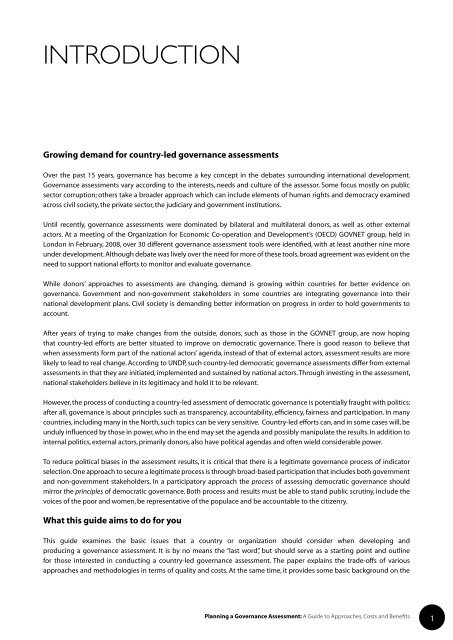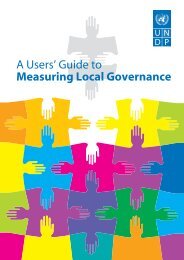planning a governance assessment - United Nations Development ...
planning a governance assessment - United Nations Development ...
planning a governance assessment - United Nations Development ...
Create successful ePaper yourself
Turn your PDF publications into a flip-book with our unique Google optimized e-Paper software.
Introduction<br />
Growing demand for country-led <strong>governance</strong> <strong>assessment</strong>s<br />
Over the past 15 years, <strong>governance</strong> has become a key concept in the debates surrounding international development.<br />
Governance <strong>assessment</strong>s vary according to the interests, needs and culture of the assessor. Some focus mostly on public<br />
sector corruption; others take a broader approach which can include elements of human rights and democracy examined<br />
across civil society, the private sector, the judiciary and government institutions.<br />
Until recently, <strong>governance</strong> <strong>assessment</strong>s were dominated by bilateral and multilateral donors, as well as other external<br />
actors. At a meeting of the Organization for Economic Co-operation and <strong>Development</strong>’s (OECD) GOVNET group, held in<br />
London in February, 2008, over 30 different <strong>governance</strong> <strong>assessment</strong> tools were identified, with at least another nine more<br />
under development. Although debate was lively over the need for more of these tools, broad agreement was evident on the<br />
need to support national efforts to monitor and evaluate <strong>governance</strong>.<br />
While donors’ approaches to <strong>assessment</strong>s are changing, demand is growing within countries for better evidence on<br />
<strong>governance</strong>. Government and non-government stakeholders in some countries are integrating <strong>governance</strong> into their<br />
national development plans. Civil society is demanding better information on progress in order to hold governments to<br />
account.<br />
After years of trying to make changes from the outside, donors, such as those in the GOVNET group, are now hoping<br />
that country-led efforts are better situated to improve on democratic <strong>governance</strong>. There is good reason to believe that<br />
when <strong>assessment</strong>s form part of the national actors’ agenda, instead of that of external actors, <strong>assessment</strong> results are more<br />
likely to lead to real change. According to UNDP, such country-led democratic <strong>governance</strong> <strong>assessment</strong>s differ from external<br />
<strong>assessment</strong>s in that they are initiated, implemented and sustained by national actors. Through investing in the <strong>assessment</strong>,<br />
national stakeholders believe in its legitimacy and hold it to be relevant.<br />
However, the process of conducting a country-led <strong>assessment</strong> of democratic <strong>governance</strong> is potentially fraught with politics:<br />
after all, <strong>governance</strong> is about principles such as transparency, accountability, efficiency, fairness and participation. In many<br />
countries, including many in the North, such topics can be very sensitive. Country-led efforts can, and in some cases will, be<br />
unduly influenced by those in power, who in the end may set the agenda and possibly manipulate the results. In addition to<br />
internal politics, external actors, primarily donors, also have political agendas and often wield considerable power.<br />
To reduce political biases in the <strong>assessment</strong> results, it is critical that there is a legitimate <strong>governance</strong> process of indicator<br />
selection. One approach to secure a legitimate process is through broad-based participation that includes both government<br />
and non-government stakeholders. In a participatory approach the process of assessing democratic <strong>governance</strong> should<br />
mirror the principles of democratic <strong>governance</strong>. Both process and results must be able to stand public scrutiny, include the<br />
voices of the poor and women, be representative of the populace and be accountable to the citizenry.<br />
What this guide aims to do for you<br />
This guide examines the basic issues that a country or organization should consider when developing and<br />
producing a <strong>governance</strong> <strong>assessment</strong>. It is by no means the “last word”, but should serve as a starting point and outline<br />
for those interested in conducting a country-led <strong>governance</strong> <strong>assessment</strong>. The paper explains the trade-offs of various<br />
approaches and methodologies in terms of quality and costs. At the same time, it provides some basic background on the<br />
Planning a Governance Assessment: A Guide to Approaches, Costs and Benefits








![GuÃa del Usuario ] - Governance Assessment Portal](https://img.yumpu.com/44740603/1/190x253/gua-a-del-usuario-governance-assessment-portal.jpg?quality=85)







